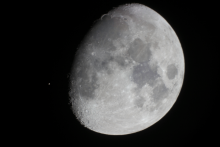Listen to today's episode of StarDate on the web the same day it airs in high-quality streaming audio without any extra ads or announcements. Choose a $8 one-month pass, or listen every day for a year for just $30.
You are here
Moon and Aldebaran
The Sun is pretty big as stars go — bigger than more than 90 percent of all the other stars in the universe. It’s more than a hundred times the diameter of Earth — big enough to fit about 1.3 million Earths inside it.
At the end of its life, however, the Sun will grow far larger than it is today. In fact, it’ll closely resemble Aldebaran, the bright eye of the bull. The star rises to the lower right of the Moon late this evening.
Aldebaran is classified as a giant. It’s about 44 times the Sun’s diameter, and about 85,000 times its volume.
For most of its lifetime, Aldebaran probably wasn’t too much bigger than the Sun is today. Eventually, though, it burned through all the hydrogen gas in its core. Today, it’s probably consuming a shell of hydrogen around the core. That’s caused its outer layers to puff up like a giant balloon. It’s also caused those layers to get thinner and cooler. The lower temperature makes Aldebaran shine bright orange.
Before long, Aldebaran will begin burning the helium that now makes up most of its core. When that happens, it’ll briefly get even bigger and brighter. At the end, it will shed its outer layers, leaving behind only its hot but dead core — a tiny ball of cosmic ash known as a white dwarf. It’ll spend billions of years cooling and fading from sight.
The Sun will go through that whole process as well — beginning in about five billion years.
Script by Damond Benningfield




